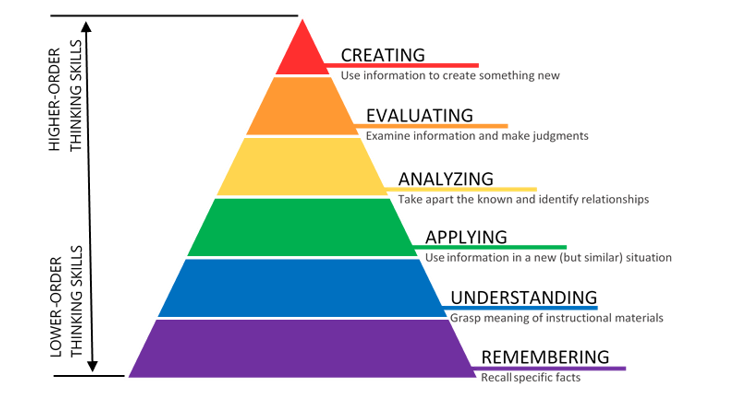In September 2020, we published an article promoting Blended Learning[1] as our recommended approach to structuring a course. Blended Learning combines the best aspects of both classroom and online learning, and our version incorporates a flipped classroom approach. All course content is designed and posted on a learning management system (LMS) and students review the content and complete any assignments prior to participating in a synchronous class. The class meeting with the instructor could be either in person or online or could switch between the two seamlessly.
Simply stated, instructors assign various asynchronous activities for learners to complete before class (lecture videos, assignments {reading, problems, essays}, team projects, group discussions, knowledge checks, etc.). Actual “class time” with the instructor is dedicated as an active learning environment that applies the concepts in the material for the week and can be either in person or virtual, it does not matter which since many video conferencing platforms accommodate breakout groups and simulate group meetings just like you would do in an actual face-to-face classroom.
So, what is Active Learning? It is an instructional approach that actively engages students in the learning material through a variety of different approaches such as problem-solving activities, writing assignments, group discussions, reflection activities, projects, teamwork, and any other task which promotes critical thinking about the subject. Active learning is learner-centered and requires that students actively engage in the learning materials to develop the skills more fully. To quote Eric Mazur[2] from Harvard “in some instances, we must teach the student to engage in self-learning”. The students must own their education and take responsibility for it!
This is a substantial shift from traditional classroom teaching models where the instructor lectures and provides information which the students dutifully record (passive learning). Active learning shifts the focus of learning the materials to the learner. It uses all three learning-style preferences: visual, auditory, and particularly kinesthetic.
Why use Active Learning?
Active Learning:
- Reinforces important concepts and builds skills.
- Provides immediate feedback from the instructor since he/she is available in the class period as a resource. To quote the One Minute Manager[3] “feedback is the breakfast of champions”.
- Allows the students time to discuss and think about the application of course content.
- Creates a sense of community among the students through increased student to student and student to instructor interaction.
- Allows students to practice important skills in collaboration and teamwork.
Active Learning has been shown to be superior to passive lecturing as it promotes both comprehension and memory as well as analysis and application. The reason it is so effective is that it draws on the underlying characteristics of how the brain operates during learning. These characteristics have been documented by thousands of empirical studies[4].
At best, traditional classrooms teach students the lower order thinking skills of Blooms Taxonomy: remembering and understanding. Using the flipped classroom and active learning approach to course design offers the opportunity for the student to experience the applying and analyzing levels at a minimum and, if fully successful, all the way up to evaluating and creating. The content is much stickier! It is simply a better way to learn!
BLOOMS TAXONOMY – COGNITIVE DOMAIN (2001)

Source: University of Florida CIT
Planning an Active Learning Class
Many experienced and effective instructors who are used to the “sage-on-the-stage” lecture method have trouble even imagining how to make the switch to an active classroom. Let us not kid ourselves, making this switch takes work for the instructor. They have to learn how to facilitate and change their role in the class from lecturer to senior member of the class, coach, and mentor.
One benefit for instructors, however, is that a flipped classroom removes the relentless requirement of repeating and lecturing the same basic content each semester, freeing up valuable faculty time for other instructional activities. Instead of class time filled with lecture, instructors record short content-rich lectures on core content for students to review in advance and use class time for mentoring, coaching, answering questions and helping students learn to apply the content. Watching short lecture videos before class is also valuable to the students because they can work at their own pace, repeating videos on more difficult topics, while moving quicker on ones they found easier to master. The inclusion of quick knowledge checks in the pre-work, provides feedback and motivation for students as they master new content.
When the class does meet, either virtually or in person, the instructor goes from sage-on-the-stage traditional lecture model to being a facilitator of active learning for the students. Students are prepared when they come to class and ready to ask questions for understanding, rather than hearing course content for the first time in class. This shifts the focus of the instructors’ interactions with students to discussion, application, clarification, and peer collaborations, making the learning stickier and easier to remember and apply. Active classrooms are naturally student-centered; the instructor is the guide and students are actively tasked with their own learning. The blended learning model also builds on the opportunity for students to learn from each other by coaching their peers, providing feedback, and executing group projects.
There is one more reason to move to a blended/flipped course design. The same pre-work course materials can be used for an online course with the online videoconference becoming the “classroom” to facilitate active learning. So, if a blended course is launched as a campus offering and temporary or major disruptions occur (and they periodically do, right?) the switch to teaching online is immediate and seamless without missing a beat.
For learning how to facilitate the class, you might think of it as facilitating a workshop. If you did not give a quiz before class starts, you might start the class by giving a quiz that is designed to hit the key concepts of the material for the week. The quiz can be administered on your LMS.
After the quiz, lead a discussion on any question’s students had trouble with. Then you might give the class an assignment and have them subdivide into breakouts of 3 to 5 students each. While they are discussing the problem, you can circulate around the room to answer questions or even pose deeper questions. Advanced video conferencing platforms like Zoom have breakout rooms so you can do the same whether on-line or on campus. Have each group report out. They benefit from the practice of presenting to the class. One of our colleagues runs the quiz before class and starts the class with a story – people always remember stories!
There are many types of classroom assignments, projects, and games that you might use. One of our main goals as instructors is to provide opportunities which empower the students to take more control and drive their own learning. One technique that worked well for me is to assign different case studies or projects to each team and use the reports from the team to stimulate class discussion. My colleagues recommend mixing the team composition up each week so that students learn to work with many different types of people.
By providing students a chance to do more than absorb information, we create the environment in which they can be creative, design solutions, and think critically and hopefully they learn to self-assess and reflect. There are many ways to manage a flipped classroom and you need to find what makes you most comfortable. Certainly, experimenting with an open mind will give you the opportunity to find what works best for you and your learners.
A good exercise to finish a class meeting is to “go around the room” and have each learner state what was most meaningful to them in the week’s materials. They should use laser comments to not take more than the prescribed time, say 20 – 30 seconds. This simple little drill encourages them to think about everything they have learned for the week and provides a good review of major content.
As always, Google is your best friend. There are a lot of papers on every aspect of active learning and there are plenty of sources for case studies, exercises, and games. To support flipped classroom teaching, consider obtaining these certifications from the Flipped Learning Global Initiative[1]:
- Flipped Learning Level – I
- Flipped Learning Level – II
- Flipped Learning Basic Trainer Certification Level – I
- Flipped Learning 3.0 Higher Ed Certification Level – I
- Flipped Learning 3.0 Differentiation Strategies
A few other ideas that we have found work very well include:
- Have the students set their goals for the semester in the first session and then revisit periodically to keep on track,
- Have the students form study groups of 3 to 5 students to review materials together [students that actively do this finish with one grade higher!],
- Have students find a buddy in the group to keep each other accountable for performance; and
- Have students write a reflection piece on how the course reflects and reinforces their most important values.
As with most things in teaching, you must find a solution that works for you. There are many ways to run an effective blended/flipped learning environment, just keep at it until you are comfortable. Your students will thank you!
Selected Reverences
- How Video Production Affects Student Engagement: An Empirical Study of MOOC Videos by Phillip Guo, Juho Kim, and Rob Rubin
- 3 Ways to Implement Blended Learning I The Classroom by Rachelle Dene Poth
- Student-Centered Learning in a Blended Classroom by McGraw-Hill
- The Basics of Blended Instruction by Catlin r. Tucker, Educational Leadership
- What is Active Learning by Muhammad Taha Junaidy, UMD PM Graduate Student
- Essential Facilitation Skills for an Effective Facilitator by Robert from Session Lab
[1] Cable, J. H. (2020). Converting to Online Teaching: A Series of short guidance articles for educators and institutions – Blended Learning Classroom Guidance, PM World Journal, Vol. IX, Issue IX, September
[2] https://www.physics.harvard.edu/people/facpages/mazur
[3] The One Minute Manager by Kenneth Blanchard, Ph.\D, and Spencer Johnson, M.D.
[4] Smith & Kosslyn, 2011
This article appeared in PM World Journal, Vol. X, Issue VI, June 2021.

John Cable, Director, Project Management Center for Excellence, University of Maryland
How to cite this article: Cable, J. H. (2021). Converting to Online Teaching: A series of short guidance articles for educators and institutions –What is Active Learning? Tips for Designing and Managing an Active Clasroom, PM World Journal, Vol. X, Issue VII, July.
Posted by Kathy Frankle on July 7, 2021

 Data Analytics for the Project Manager
Data Analytics for the Project Manager